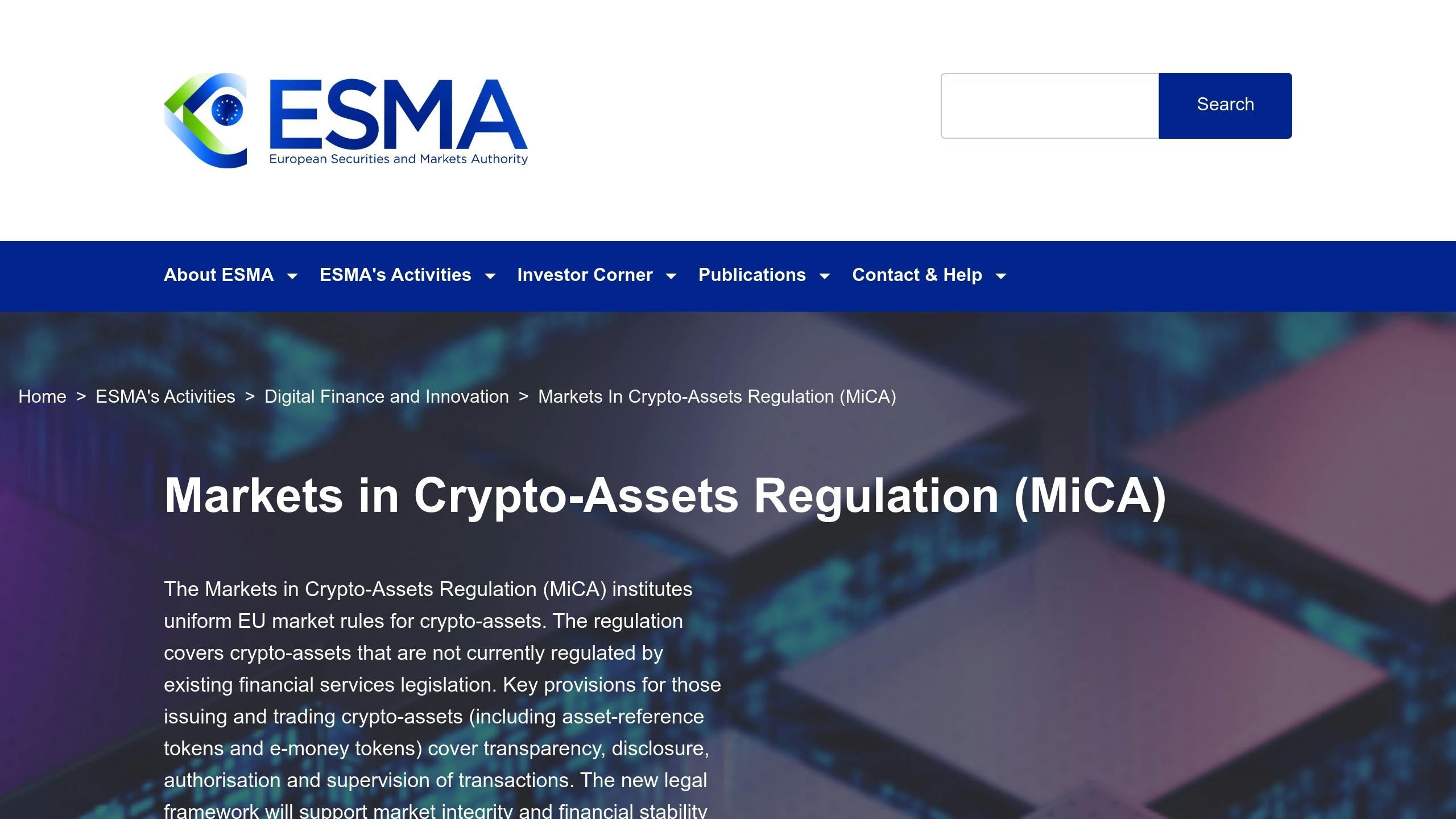New EU Crypto Rules Cap Leverage at 2:1
The European Securities and Markets Authority (ESMA) is reshaping crypto trading in the EU with its MiCA regulations, fully effective as of December 30, 2024. Retail traders now face a maximum leverage of 2:1, far below the 50x offered by decentralized exchanges like Defx Perps DEX. These rules aim to protect investors from heavy losses while enforcing transparency and compliance.
Key Changes Under MiCA:

- Leverage Limits: Retail trading capped at 2:1.
- Investor Protections: Negative balance protection and margin close-outs at 50% collateral.
- Marketing Restrictions: Bans on sign-up bonuses and risky promotions.
- Transparency: Platforms must disclose retail loss percentages and provide risk warnings.
Centralized vs. Decentralized Platforms:
- Centralized Exchanges: Must comply with MiCA’s strict rules, including capital buffers and organizational separation.
- Decentralized Exchanges (DEXs): Face challenges in meeting compliance due to non-custodial and algorithmic setups. Defx Perps DEX, for instance, continues offering up to 50x leverage, prioritizing flexibility over regulation.
| Aspect | ESMA Rules | Defx Perps DEX |
|---|---|---|
| Leverage | 2:1 | Up to 50x |
| Compliance Method | Organizational separation | Code-based via smart contracts |
| Risk Management | Negative balance protection | Smart contract liquidations |
These changes create a divide between regulated centralized exchanges and decentralized platforms, leaving traders to choose between safety and flexibility.
What the New ESMA Leverage Rules Mean for European Traders

1. ESMA MiCA Rules
MiCA’s rules for leverage trading focus on three main areas:
The core regulation imposes a 2:1 leverage limit for cryptocurrency trading:
| Asset Type | Maximum Leverage |
|---|---|
| Cryptocurrencies | 2:1 |
This limit stands in stark contrast to platforms like Defx Perps DEX, which allow leverage as high as 50x. This highlights the regulatory divide between centralized and decentralized exchanges.
Key safeguards include automated margin close-outs when collateral drops to 50% and mandatory measures to prevent negative balances, ensuring retail traders avoid debt risks.
The rules also place tight restrictions on marketing and promotions. Prohibited incentives include sign-up bonuses, trading credits, and promotions that encourage risky behavior.
Transparency is another cornerstone. Platforms are required to display standardized risk warnings and disclose the percentage of retail accounts that incur losses. They must also have strong systems to manage conflicts and protect clients. For example, trading operations and risk management functions must remain organizationally separate [1][2].
Professional qualifications are also addressed. Advisors must complete 160 hours of training and have at least one year of experience. General information providers, on the other hand, need 80 hours of training and six months of supervised experience [4].
These rules present operational hurdles for decentralized platforms like Defx Perps DEX, which must rely on technical solutions rather than traditional organizational changes to comply.
sbb-itb-dd9e24a
2. Defx Perps DEX Features

Defx Perps DEX takes a decentralized approach, which stands in contrast to ESMA’s strict regulatory framework:
The platform supports margin trading with both isolated and cross-margin options. These features, however, go beyond MiCA’s leverage limits[5][6].
| Feature | Current Implementation | ESMA Compliance Challenges |
|---|---|---|
| Margin Systems | Isolated and cross-margin with high-throughput matching[5] | Requires stricter protection measures[6] |
| Token Markets | Pre-launch trading available[5] | Could face regulatory classification issues[6] |
| Platform Architecture | Non-custodial structure[5] | Incompatible with centralized monitoring requirements[6] |
The platform’s non-custodial setup directly opposes MiCA’s market surveillance rules, particularly the centralized monitoring outlined in Article 81[2][3].
Additionally, its cross-chain design boosts liquidity but complicates compliance with ESMA’s AML/CFT standards, which demand monitoring across multiple chains[2]. These design choices highlight the ongoing struggle to balance decentralized finance innovation with the EU’s regulatory framework.
Key Differences and Similarities
ESMA’s framework and Defx Perps DEX operate differently in three key areas:
| Aspect | ESMA Requirements | Defx Perps DEX |
|---|---|---|
| Capital Buffer | €150,000 or 2% crypto asset ratio [5] | Algorithmic liquidity pools |
| Compliance Method | Organizational separation of functions | Code-based enforcement via smart contracts |
| Risk Disclosure | Standardized retail warnings [5] | Transaction-level blockchain visibility [6] |
When it comes to user protection, ESMA enforces negative balance protections [5], while Defx uses smart contract-driven liquidations. Both approaches aim to uphold market integrity, though their methods differ: ESMA implements surveillance requirements, whereas Defx ensures transparency through on-chain order matching [6].
These differences highlight the ongoing clash between regulatory frameworks like MiCA, which prioritize investor protections, and DeFi’s commitment to open, permissionless trading in leveraged cryptocurrency markets.
Conclusion
The analysis highlights the ongoing clash between ESMA’s MiCA framework and the decentralized trading model. With the regulations set to take full effect on December 30, 2024[7], this tension becomes a defining feature of the EU’s crypto leverage trading environment.
Traders face a clear choice: ESMA’s investor protection measures or the autonomy offered by decentralized exchanges like Defx Perps DEX, which continues to provide 50x leverage through its decentralized setup. ESMA’s directive for national authorities to ensure CASP compliance by Q1 2025[5] points to increased regulatory scrutiny. These developments could shape how decentralized trading is governed globally[7].
This shift reflects a broader challenge within DeFi: a divided market structure that forces traders to weigh safety against flexibility. The future stability of the market will hinge on how both systems manage risks while staying true to their core principles.
